For most of my tennis career, I have focused on playing doubles.
I enjoy it so much because of the aggressive net play that makes up much of the game.
In this post, I will introduce you to basic doubles strategy which will help you gain an understanding of why it is important and help you to win more matches.
Here is what I will be covering:
- Why is doubles strategy so important?
- Doubles Tennis Strategy Basics
- Tennis Mixed Doubles Strategy
- Tennis Doubles Strategy Poaching
- Tennis Doubles Net Strategy
- Tennis Doubles Strategy Against Lobbers
- Tennis Doubles Volley Strategy
- Tennis Doubles Strategy Drills
- Frequently Asked Questions: Doubles Strategy
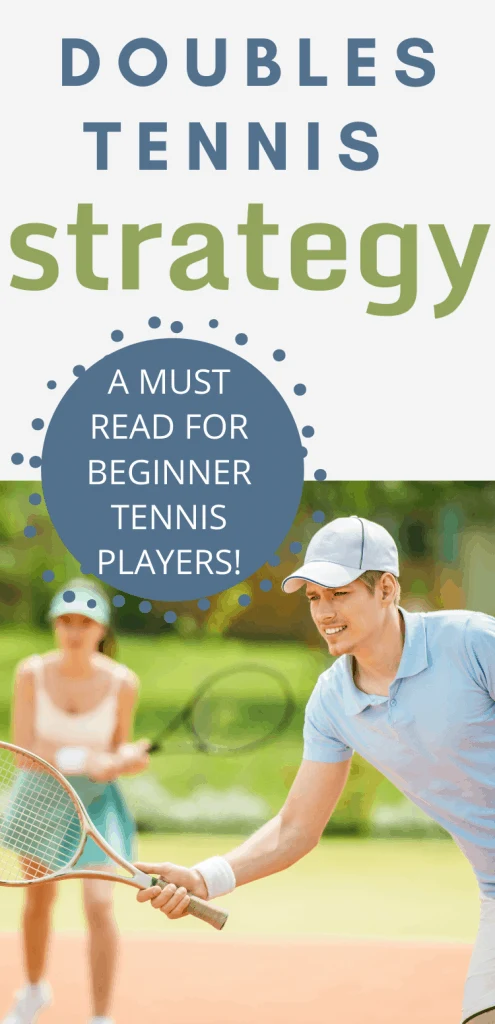
Why is Strategy So Important in Doubles Matches?
If you’re used to singles tennis, you know that the goal is to efficiently command the entire court.
In a game of singles, you may do net play and play at the baseline at the same point.
Doubles, on the other hand, requires the art of collaboration.
You will usually be delegated to the net or the baseline for each point. Any shifting or trading of roles in doubles requires clear communication and diligent practice.
It is clumsy and frustrating when partners steal shots from each other, or when they bungle communication so that neither player is available to return a shot.
A common understanding of doubles principles and effective in-game communication is key to success on the court.
Doubles Tennis Strategy Basics
In doubles, partners share serving duties game by game.
In most situations, it is best to serve from halfway between the center of the baseline and the inner border of the ally.
This differs from singles, where one normally serves near the center of the baseline.
Correspondingly, when receiving the serve, you may also set up closer to the corner than you would in a singles game.
If you’re at the net while your partner is serving, it is best to start at the center of the box.
Stand close to the net on the first serve because your opponent is less likely to have a good return.
You may want to start a little further back on the second serve because your opponent’s return is likely to be stronger.
Stay light on your feet and look alive! Don’t be afraid to cross the centerline if you see an opportunity to knock a shot down.
The best shots at the net are either low at your opponents’ feet or down the line, keeping the middle open for your partner.
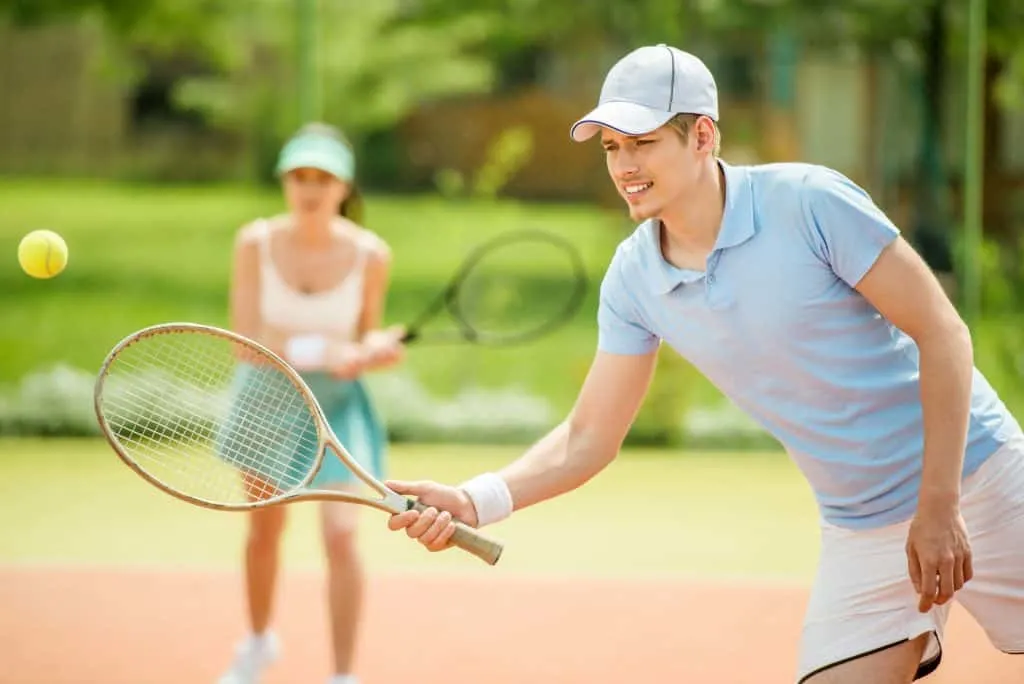
Tennis Mixed Doubles Strategy
In general, the strategy for winning gameplay in mixed doubles is much the same as any game of doubles tennis.
However, there are a few points of tennis etiquette to keep in mind to get the most enjoyment out of mixed doubles.
Avoid aggressively targeting one member of the opposing team who you may perceive as a weaker player or less experienced.
Do not take out your frustration on your own partner if they cannot cover for your mistakes, and do not be too controlling of the entire court.
After all those “do not”s, here are some “do”s: do be supportive of your partner if they are still learning the game.
Treat opponents who are still learning with respect and understanding, and invest yourself more in the enjoyment of spending time together and learning the game than in rejoicing victory, or agonizing defeat.
Tennis Doubles Strategy Poaching
Poaching is a strategy you can use at the net when your teammate is serving.
The goal is to make the most of your opponent’s weak return by striking it down right at the net, rather than letting it travel deeper into your side of the court.
The best starting position for poaching is in the center of the box.
If your teammate’s serve is wide, you may want to shift slightly toward the alley. The efficiency of motion is the key to effective poaching: try to get to the net in as few steps as possible by using diagonal motion.
Try to make a split step, then one diagonal step out, and finally one more long step across as you extend your racket.
If the return is going over the center of the net, use the center stripe as a reference point. If they hit it down the line, then move diagonally toward the outer end of the net.
Standard Doubles Formation
The standard doubles formation looks like this.
If you are serving then you are standing at the baseline just like you would in singles.
Your partner then stands somewhere between the net and the service line opposite you.
Your opponents would have the tennis player returning the serve located somewhere between the baseline and service line diagonal from the server.
The other player is usually located to the left of right of their teammate near the service line, standing ready to approach the net.
Switch it Up with the I-Formation
I love this formation so much and if you are looking for a simple way to switch up your doubles play and change the pace of your tennis match give this a try.
The I-Formation is when you have both players on the same side of the court.
The server is in their normal spot near the baseline but also near mid-court instead of near the doubles alley.
The other player is crouched near the net on the same side of the court as the server.
What does this do?
It forces your opponent into the land of the unknown which means mistakes can be made!
Do they try to hit it down the lines in hopes to score the point?
Do they hit it cross-court and hope that their opponent doesn’t smash a volley?
Even if you just do this every now in then it can be a great strategy to throw into the rotation.
You may also want to use hand signals to communicate where you want you partner to serve and which way you will be moving once the ball is in play.
Communication is essential in this technique!
Australian Formation
The Austrailian formation is very effective and it’s fairly easy for anyone to use.
This tennis doubles strategy has been played for many years and still continues to be a top tennis strategy used today.
What is Australian Formation?
Australian formation is when you have the net player stand directly across from the other net player.
The server serves more from the middle (always got to be switching up those angles!)
You will want to serve out wide if possible to make the return a bit more challenging.
The net player should be ready to then grab a mid-court volley.
Tennis Doubles Positioning
When your partner is serving, you may want to stand a little bit deeper than the singles service line.
The depth of your position depends on several factors: how far back you start on the return of serve, where your partner sets up when their turn comes, and (you guessed it) tennis doubles strategy.
If your partner’s serves are hard for your opponent to hit back then I would stand a bit closer and ready to attack the net.
If they are not as strong at serving you think your opponent will easily return it then you may want to linger a bit before rushing the net in case you need to get back to the baseline.
When your opponents are serving, you should determine if it is a serve that can be knocked down or one that needs to be returned.
Start closer to the net on the first serve and further back on the second if necessary.
Cover both sides of the tennis court by standing at least halfway between where your opponents stand.
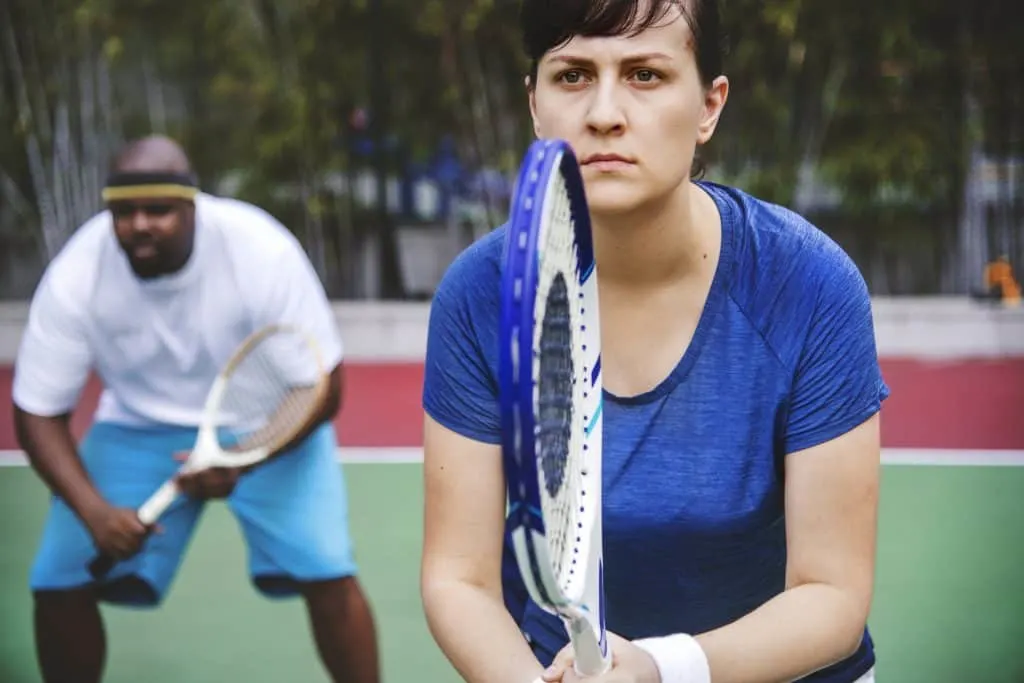
Tennis Doubles Net Strategy
Playing at the net can be intimidating!
There is so little space buffering you from your opponents’ shots, it can leave you feeling vulnerable.
It demands quick reaction time, but there are strategies to make the net position easier.
Your default position should be the center box. It positions you to return shots up the middle, as well as in the alley.
Keep your hands in front of you, stay low so you’re ready to spring in any direction, and don’t shy away from the ball when it approaches.
If you recoil backward, you have less control over your return. Stay forward or neutral and keep your swing short and efficient.
One tennis drill you can use to practice your net position is to rest your racket on the net, and then bend your knees so the tip of the racket starts to come up. This will show you how to keep your hands and your racket in front of you while you’re resting.
Then have your practice partner feed you some shots, and make sure your racket stays out in front of the net.
This is not legal tennis play, but the net gives you a physical reminder of proper form at the net that you can apply to actual doubles play.
Tennis Doubles Strategy Against Lobbers
The most important thing to remember when dealing with lobs is that it is easier to move quickly forward than quickly backward.
As soon as you see the ball go up, you should turn and take 2-3 long strides toward the back of the court. If the lob is fairly short, it should be easy to reach up and take an overhead shot.
When your opponent sends a deep lob all the way back to the service line, the head start you got by starting back quickly will allow you to set up for a good return instead of continuing to backpedal while taking your shot.
Tennis Doubles Volley Strategy
Don’t overdo your backswing on a standard volley – create a target for the ball to hit instead of winding up. Swing high to low to create underspin.
If you base the spin in your wrist, it is hard to create consistency in the slice.
To create more power in your swing, turn your upper body to store energy like a coil, and release the energy by stepping with the front foot and following through with the swing.
Even as the serving partner, it’s best to try to close in on the net because then you don’t have to generate as much power to make a good shot, and it gives you a better variety of angles to choose from.

Win Your Doubles Match By Getting Serves In
It doesn’t matter if you are playing a doubles tennis game or singles…you need to get your serves in…especially the first!
What is the easiest shot to hit?
A soft second serve!
The goal of the second serve is to just get the ball in so oftentimes they are easy for your opponent to smash wherever they want on the court.
We can avoid that situation completely by making sure our first serves are strong and consistent.
When you hit that first serve well you start the point off right because your opponent is going to do anything they can to get the ball back to the other side of the court even if it is just an easy volley for your doubles partner to smash back!
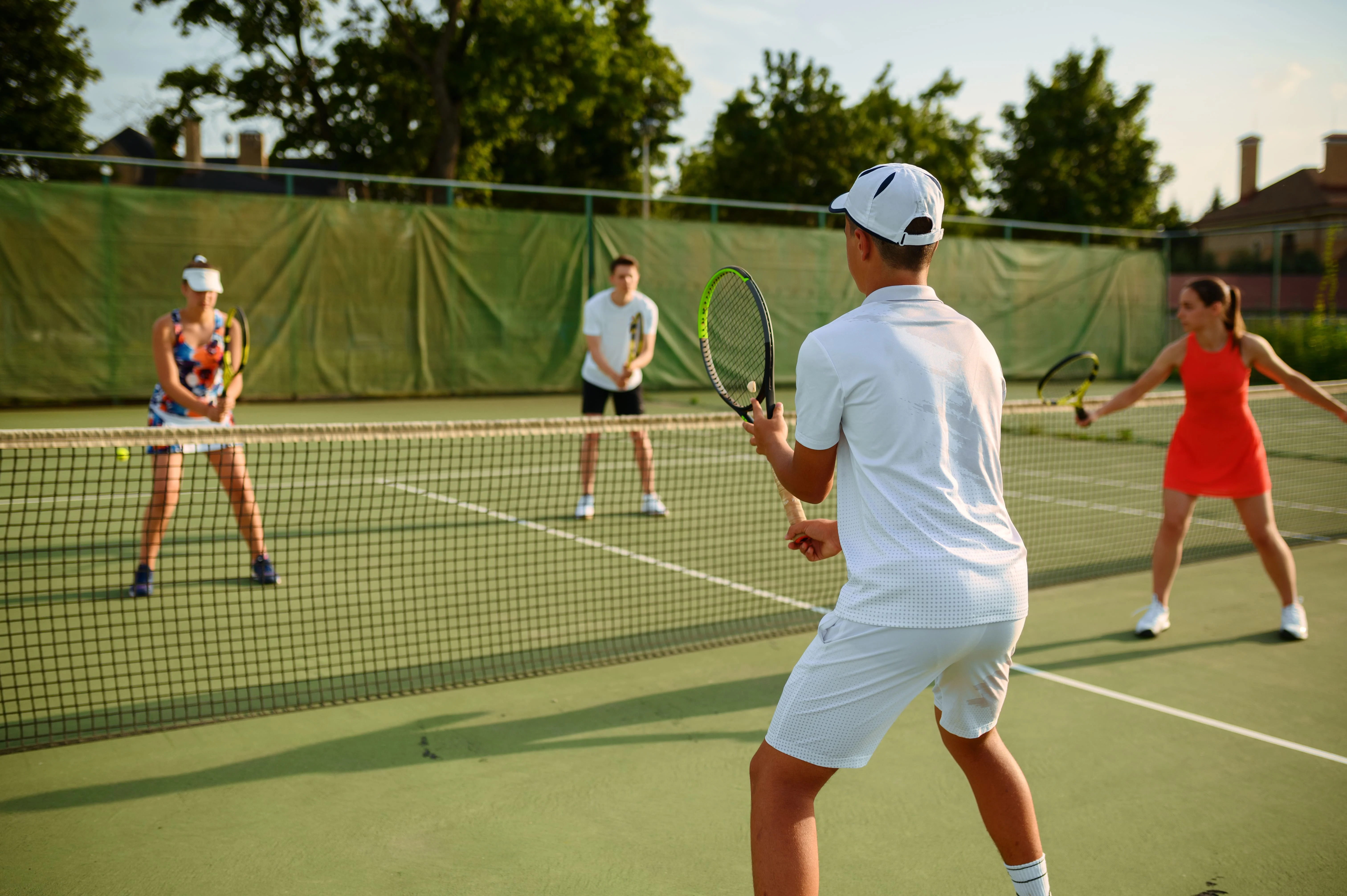
Use Your Opponent’s Weakness as Part of Your Plan
Make sure to take time during warm-up and the start of your match to get to know what your opponent is really talented at and where their weaknesses lie.
Using this knowledge can be a great tactic and a smart way to get free points as they make errors.
For the first few games see if there is anything that seems to throw your opponents off balance.
Are they strong net players?
Do they seem to have a weak backhand?
Use these clues to steer where you hit the ball and what your doubles game should look like.
Make sure to have good communication with your partner about what they notice as well.
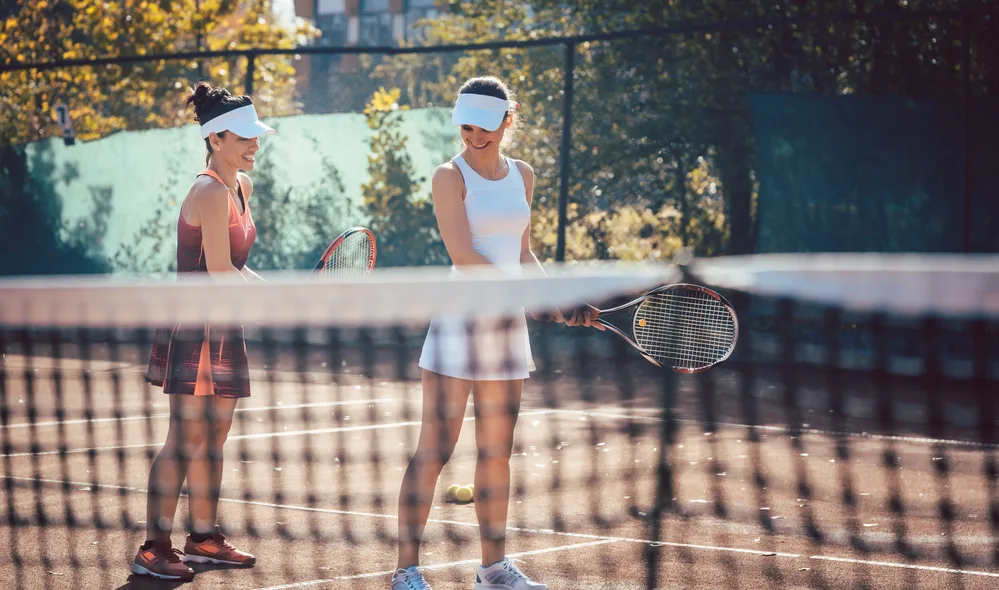
Communication Should Be Your Primary Goal
If you are not communicating in doubles, you won’t win if you play your opponent against equal rivals.
I played doubles for many years and with different doubles partners.
If you and your partner are new make sure that you give plenty of time to get used to each other to see if you’re a good match.
If you have played a lot of tennis then you may too have experienced some partners that you just seemed to click with while others it took longer to you to get your groove down.
When expressing constructive criticism be a positive voice, else it may look bad.
Speak to them like you would want to be spoken to.
Make sure you ask for feedback from them as well because you don’t want to be the one that does all the talking!
Be patient as you get to know your doubles partner as these things take time and patience!
Work as a Team to Cover the Court Angles
One of the best parts of playing doubles is you no longer have to cover the whole court by yourself! Yay!
But again…the court did just gt a bit bigger right?
The advantage to this that you can have is to really play up the angles.
Make Opponents uncomfortable by mixing up your serve to keep them on their toes!
If you are comfortable play with the speed and angle of your first and second serve and see what works.
When you are on the return make sure that if your opponent chooses to utilize the doubles alley make sure to cover the middle of your court if your opponent is on the edge.
Tennis Doubles Strategy Drills
Baseline rally drills: Hit as many shots as you can with the ball crossing into the alley before crossing the baseline. That oblique angle is advantageous in doubles play because it keeps the middle of the opponents’ court more open.
Net game: One player is on the baseline, and the other is at the net, aiming at the doubles alley only.
This works on your volley precision as a net player. Aiming in that direction helps you avoid hitting toward the other net player.
Work on moving forward toward the net with each shot, which helps you even more easily avoid the opposing net player and gives you a better angle to aim the shot anywhere on the court.
The best way to improve your skills for playing tennis doubles is by playing practice matches and making sure you care communicating well with your partner.
If you are not on the same page as your partner it will cause lots of errors on the court so it is very important that you are on the same page.
In doubles tennis, you serve anywhere on the baseline including the doubles alley.
You will want to focus on your partner’s strengths instead of their weaknesses.
You can read more about how to win doubles tennis with a weak partner here.
Related Posts You Will Enjoy
Quotes about Tennis You Need to Know
Best Tennis Tips for Beginners
What to Wear Playing Tennis with Friends
Tennis Serve Drills You Need to Try

